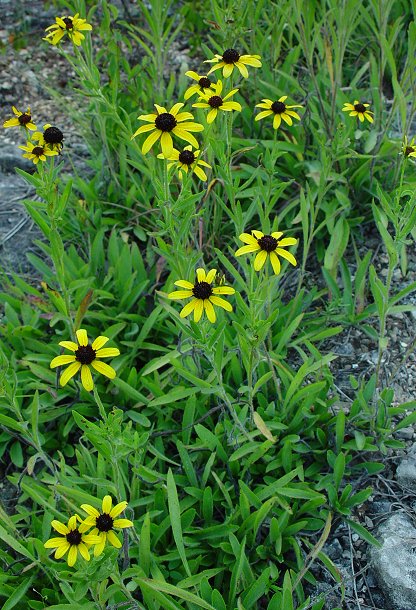Rudbeckia missouriensis Engelm. ex C.L. Boynton & Beadle
Missouri Coneflower

Native
CC = 6
CW = 3
MOC = 44
© DETenaglia
Rudbeckia missouriensis Engelm. ex C.L. Boynton & BeadleMissouri Coneflower | |
 |
Native CC = 6 CW = 3 MOC = 44 |
© DETenaglia |
|
Family - Asteraceae/Heliantheae Habit - Perennial forb with fibrous to somewhat fleshy roots and stout rhizomes. New basal rosettes usually present immediately adjacent to the older stems. Stems - Erect, to 80 cm, multiple from the base, branching at the apex, moderately to densely pubescent with relatively long, spreading hairs, scabrous, not glaucous.
Leaves - Basal and alternate, simple, unlobed, tapered or angled at the base, only slightly expanded at the base and inconspicuously wrapping around the stem, the margins entire or with a few inconspicuous, sharp teeth, with a single midrib and 2 prominent lateral veins arising near the base of the blade, the surfaces moderately to densely hairy with mostly spreading, minutely pustular-based hairs, scabrous, not glaucous, green to grayish green when fresh. Basal and lowermost stem leaves often present at flowering (or present on adjacent rosettes), more or less sessile to short-or less commonly long-petiolate, the blade 5-20 cm long, 5-20 mm wide, broadly linear to oblanceolate or narrowly spatulate, rounded or more or less angled to a bluntly pointed tip. Median and upper stem leaves sessile, the blade 2-15 cm long, 4-10 mm wide, linear to narrowly oblong-lanceolate, angled or short-tapered to a bluntly or sharply pointed tip.
Inflorescence - Single pedunculate flower head terminating each stem, usually appearing as strongly ascending clusters, the peduncles hollow below the receptacle.
Heads - Involucral bracts 10-20, 6-14 mm long, ovate to lanceolate, the surfaces sparsely to densely hairy, the margins usually with moderate to dense, ascending hairs. Receptacle 8-15 mm long, 10-17 mm in diameter, hemispherical at the start of flowering, then elongating somewhat and sometimes becoming ovoid. Chaffy bracts subtending only the disc florets, shorter than the disc florets (including the corolla), short-tapered to a broadly triangular, usually sharply pointed tip, the outer surface glabrous and often somewhat shiny, the margins usually glabrous.
Flowers - Ray florets 9-15, sterile, the corolla 10-25 mm long, relatively slender, spreading to slightly drooping at flowering, yellow or less commonly the basal portion orangish- or reddish-tinged, shallowly notch at the apex, the outer surface sparsely to moderately short-hairy. Disk to 1.5 cm broad. Disc florets numerous, the corolla 3.5-4.5 mm long, greenish yellow toward the base, dark purplish brown toward the tip, the lobes ascending at flowering. Stigma lobes relatively short and bluntly pointed at the tip. Pappus a minute rim or crown.
Fruits - Achenes 1.5-3.0 mm long. Flowering - June - October. Habitat - Glades, ledges and tops of bluffs, rocky prairies, rocky openings of dry upland forests, roadsides. Usually found on limestone and dolomite substrates. Origin - Native to the U.S. Lookalikes - Mainly, other species of Rudbeckia; more broadly, many other species in the Astereae and Heliantheae tribes. Other info. - This is a characteristic Missouri Ozark species, found mainly in the Ozark and Ozark Border regions in the southern half of Missouri. Beyond Missouri, smaller populations are found in only a few other states to the south. In Missouri it is quite common in the habitats mentioned above, often forming colonies of hundreds of stems. The plant is identified by its dry upland habitat, numerous leafy offsets, erect stems with leaves generally pointing upward, and flowering heads with yellow rays and dark disks. The entire plant is very hairy. It does well in sunny, dryish garden locations, and is well adapted to Missouri's hot, humid summers. Photographs taken off Hwy 106, Shannon County, MO., 8-10-03 (DETenaglia); also at Shaw Nature Reserve, Franklin County, MO, 7-20-2007 and 7-25-2020, and Danville Conservation Area, Montgomery County, MO, 8-21-2015 and 4-25-2017 (SRTurner). |